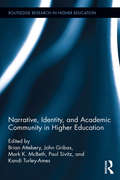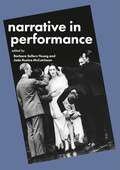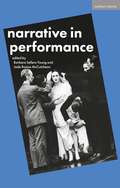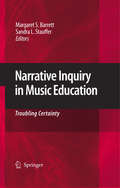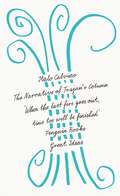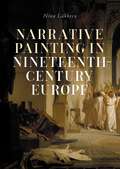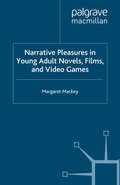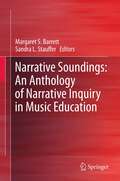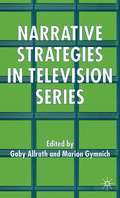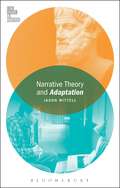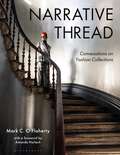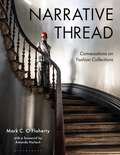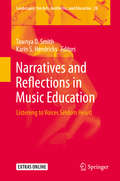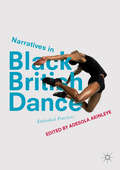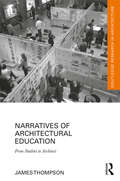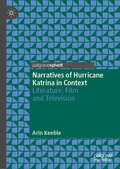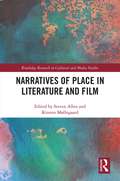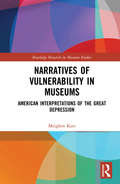- Table View
- List View
Narrative, Identity, and Academic Community in Higher Education (Routledge Research in Higher Education)
by Brian Attebery John Gribas Mark K. McBeth Paul Sivitz Kandi Turley-AmesGrounded in narrative theory, this book offers a case study of a liberal arts college’s use of narrative to help build identity, community, and collaboration within the college faculty across a range of disciplines, including history, psychology, sociology, theatre and dance, literature, anthropology, and communication. Exploring issues of methodology and their practical application, this narrative project speaks to the construction of identity for the liberal arts in today’s higher education climate. Narrative, Identity, and Academic Community focuses on the ways a cross-disciplinary emphasis on narrative can impact institutions in North America and contribute to the discussion of strategies to foster bottom-up, faculty-driven collaboration and innovation.
Narrative, Identity, and Academic Community in Higher Education (Routledge Research in Higher Education)
by Brian Attebery John Gribas Mark K. McBeth Paul Sivitz Kandi Turley-AmesGrounded in narrative theory, this book offers a case study of a liberal arts college’s use of narrative to help build identity, community, and collaboration within the college faculty across a range of disciplines, including history, psychology, sociology, theatre and dance, literature, anthropology, and communication. Exploring issues of methodology and their practical application, this narrative project speaks to the construction of identity for the liberal arts in today’s higher education climate. Narrative, Identity, and Academic Community focuses on the ways a cross-disciplinary emphasis on narrative can impact institutions in North America and contribute to the discussion of strategies to foster bottom-up, faculty-driven collaboration and innovation.
Narrative in Performance
by Barbara Sellers-Young and Jade Rosina McCutcheonA far-reaching and engaging overview of the role of narrative in dance and theatre performance, bringing together chapters written by an international range of scholars and subsequently creating a critical dialogue for approaching this fundamental topic within performance studies. Drawing on historical and contemporary examples of a variety of different performance genres, the book will provide a method for exploring the context of a particular form or artist and enhance students' ability to critically reflect on performance.
Narrative in Performance
by Barbara Sellers-Young Jade Rosina McCutcheonA far-reaching and engaging overview of the role of narrative in dance and theatre performance, bringing together chapters written by an international range of scholars and subsequently creating a critical dialogue for approaching this fundamental topic within performance studies. Drawing on historical and contemporary examples of a variety of different performance genres, the book will provide a method for exploring the context of a particular form or artist and enhance students’ ability to critically reflect on performance.
Narrative Inquiry in Music Education: Troubling Certainty
by Margaret S. Barrett Sandra L. StaufferMargaret S. Barrett and Sandra L. Stauffer We live in a “congenial moment for stories” (Pinnegar & Daynes, 2007, p. 30), a time in which narrative has taken up a place in the “landscape” of inquiry in the social sciences. This renewed interest in storying and stories as both process and product (as eld text and research text) of inquiry may be attributed to various methodological and conceptual “turns,” including the linguistic and cultural, that have taken place in the humanities and social sciences over the past decades. The purpose of this book is to explore the “narrative turn” in music education, to - amine the uses of narrative inquiry for music education, and to cultivate ground for narrative inquiry to seed and ourish alongside other methodological approaches in music education. In a discipline whose early research strength was founded on an alignment with thesocialsciences,particularlythepsychometrictradition,oneofthekeychallenges for those embarking on narrative inquiry in music education is to ensure that its use is more than that of a “musical ornament,” an elaboration on the established themes of psychometric inquiry, those of measurement and certainty. We suggest that narrative inquiry is more than a “turn” (as noun), “a melodic embellishment that is played around a given note” (Encarta World English Dictionary, 2007, n. p. ); it is more than elaborationon a position, the adding of extra notes to make a melody more beautiful or interesting.
The Narrative of Trajan's Column (Penguin Great Ideas)
by Italo Calvino'When the last fire goes out, time too will be finished'Italo Calvino was one of the most joyful and imaginative writers of the twentieth century. Here he muses on what the things we leave behind - whether waxworks or ancient graffiti, enigmatic maps or a crumbling Roman column - tell us about the greater truths of the world, space and time.One of twenty new books in the bestselling Penguin Great Ideas series. This new selection showcases a diverse list of thinkers who have helped shape our world today, from anarchists to stoics, feminists to prophets, satirists to Zen Buddhists.
Narrative painting in nineteenth-century Europe
by Nina LübbrenThis ground-breaking book presents a critical study of pictorial narrative in nineteenth-century European painting. Covering works from France, Germany, Britain, Italy and elsewhere, it traces the ways in which immensely popular artists like Jean-Léon Gérôme, Karl von Piloty and William Quiller Orchardson used unique visual strategies to tell thrilling and engaging stories. Regardless of genre, content or national context, these paintings share a fundamental modern narrative mode. Unlike traditional art, they do not rely on textual sources; nor do they tell stories through the human body alone. Instead, they experiment with objects, spaces, cause-and-effect relations and open-ended ambiguity, prompting viewers and reviewers to read for clues in order to weave their own elaborate tales.
Narrative painting in nineteenth-century Europe
by Nina LübbrenThis ground-breaking book presents a critical study of pictorial narrative in nineteenth-century European painting. Covering works from France, Germany, Britain, Italy and elsewhere, it traces the ways in which immensely popular artists like Jean-Léon Gérôme, Karl von Piloty and William Quiller Orchardson used unique visual strategies to tell thrilling and engaging stories. Regardless of genre, content or national context, these paintings share a fundamental modern narrative mode. Unlike traditional art, they do not rely on textual sources; nor do they tell stories through the human body alone. Instead, they experiment with objects, spaces, cause-and-effect relations and open-ended ambiguity, prompting viewers and reviewers to read for clues in order to weave their own elaborate tales.
Narrative Pleasures in Young Adult Novels, Films and Video Games (Critical Approaches to Children's Literature)
by M. MackeyStories are told today through many formats and young interpreters bring multimedia experience to bear on every narrative format they encounter. In this book, twelve young people read a novel, watch a film and play a video game from beginning to end. Their responses inform a new framework of contemporary themes of narrative comprehension.
Narrative Soundings: An Anthology of Narrative Inquiry in Music Education
by Margaret S. Barrett and Sandra L. StaufferThis volume focuses specifically on narrative inquiry as a means to interrogate research questions in music education, offering music education researchers indispensible information on the use of qualitative research methods, particularly narrative, as appropriate and acceptable means of conducting and reporting research. This anthology of narrative research work in the fields of music and education builds on and supports the work presented in the editors’ first volume in Narrative Inquiry in Music Education: Troubling Certainty (Barrett & Stauffer, 2009, Springer). The first volume provides a context for undertaking narrative inquiry in music education, as well as exemplars of narrative inquiry in music education and commentary from key international voices in the fields of narrative inquiry and music education respectively.
Narrative Strategies in Television Series
by G. Allrath M. GymnichIn the context of a systematic overview of the possibilities of applying narratological concepts to a study of TV series, ten case studies are explored in depth, demonstrating how series such as 24, Buffy, Twin Peaks, Star Trek, Blackadder, and Sex and the City make use of innovative audiovisual means of storytelling. Transgressing the traditional confines of narrative theory, the chapter authors address the question of how form, content, and function intersect in these series.
Narrative Theory and Adaptation. (Film Theory in Practice)
by Jason MittellNarrative Theory and Adaptation offers a concise introduction to narrative theory in jargon-free language and shows how this theory can be deployed to interpret Spike Jonze's critically acclaimed 2002 film Adaptation. Understanding narrative theory is crucial to make sense of the award-winning film Adaptation. The book explicates, in clear prose for beginners, four key facets important to the narrative theory of film: the distinction between practical vs. critical theory, the role of adaptation, the process of narrative comprehension, and notions of authorship. It then works to unlock Adaptation using these four keys in succession, considering how the film demands a theoretical understanding of the storytelling process. In using this unusual case study of a film, the author makes the case for the importance of narrative theory as a general perspective for filmmakers, critics, and viewers alike.
Narrative Theory and Adaptation. (Film Theory in Practice)
by Jason MittellNarrative Theory and Adaptation offers a concise introduction to narrative theory in jargon-free language and shows how this theory can be deployed to interpret Spike Jonze's critically acclaimed 2002 film Adaptation. Understanding narrative theory is crucial to make sense of the award-winning film Adaptation. The book explicates, in clear prose for beginners, four key facets important to the narrative theory of film: the distinction between practical vs. critical theory, the role of adaptation, the process of narrative comprehension, and notions of authorship. It then works to unlock Adaptation using these four keys in succession, considering how the film demands a theoretical understanding of the storytelling process. In using this unusual case study of a film, the author makes the case for the importance of narrative theory as a general perspective for filmmakers, critics, and viewers alike.
Narrative Thread: Conversations on Fashion Collections
by Mark C. O'Flaherty“I adored this book and can't recommend it highly enough” – Cathy Horyn"Beautifully executed” – Norma Kamali“A visual feast” – Giles Deacon“Entertaining, thought-provoking, and serious. Read it and learn.” – Colin McDowell"Clothes from our past shape who we are, and who we will be. Why do we hold on to certain garments and what do they tell us and others about our lives?"Mark C. O'Flaherty asks 14 individuals who work with or use clothes in a unique way: how has fashion created something significant in your life? Through fascinating conversations, and photoshoots of their private collections, in New York, London and Milan, he constructs a portrait of each person through their intimate relationships with fashion, featuring The Idiosyncratic Fashionistas, Charlie Casely-Hayford, John Matheson (McQueen Vault), Sandy Powell, Stephen Jones, Carla Sozzani, Winn Austin, Carmen Haid, Susanne Bartsch, Karlo Steel, Karim Rashid, Steven Philip, and Desmond is Amazing.How have these people used fashion as a vessel for memory or identity to develop their own narratives, and what does our relationship with clothing say about its changing nature as a commodity? With a foreword by influential fashion tastemaker Amanda Harlech, and opening conversations with three of fashion's most respected scholars, Valerie Steele, Andre Walker and Claire Wilcox, Narrative Thread is an eye-opening resource for our understanding of fashion's past and present – and its continuing importance in our lives.
Narrative Thread: Conversations on Fashion Collections
by Mark C. O'Flaherty“I adored this book and can't recommend it highly enough” – Cathy Horyn"Beautifully executed” – Norma Kamali“A visual feast” – Giles Deacon“Entertaining, thought-provoking, and serious. Read it and learn.” – Colin McDowell"Clothes from our past shape who we are, and who we will be. Why do we hold on to certain garments and what do they tell us and others about our lives?"Mark C. O'Flaherty asks 14 individuals who work with or use clothes in a unique way: how has fashion created something significant in your life? Through fascinating conversations, and photoshoots of their private collections, in New York, London and Milan, he constructs a portrait of each person through their intimate relationships with fashion, featuring The Idiosyncratic Fashionistas, Charlie Casely-Hayford, John Matheson (McQueen Vault), Sandy Powell, Stephen Jones, Carla Sozzani, Winn Austin, Carmen Haid, Susanne Bartsch, Karlo Steel, Karim Rashid, Steven Philip, and Desmond is Amazing.How have these people used fashion as a vessel for memory or identity to develop their own narratives, and what does our relationship with clothing say about its changing nature as a commodity? With a foreword by influential fashion tastemaker Amanda Harlech, and opening conversations with three of fashion's most respected scholars, Valerie Steele, Andre Walker and Claire Wilcox, Narrative Thread is an eye-opening resource for our understanding of fashion's past and present – and its continuing importance in our lives.
Narratives and Reflections in Music Education: Listening to Voices Seldom Heard (Landscapes: the Arts, Aesthetics, and Education #28)
by Tawnya D. Smith Karin S. HendricksThis volume offers chapters written by some of the most respected narrative and qualitative inquiry writers in the field of music education. The authorship and scope are international, and the chapters advance the philosophical, theoretical, and methodological bases of narrative inquiry in music education and the arts. The book contains two sections, each with a specific aim. The first is to continue and expand upon dialogue regarding narrative inquiry in music education, emphasizing how narrative involves the art of listening to and hearing others whose voices are often unheard. The chapters invite music teachers and scholars to experience and confront music education stories from multiple perspectives and worldviews, inviting an international readership to engage in critical dialogue with and about marginalized voices in music. The second section focuses on ways in which narrative might be represented beyond the printed page, such as with music, film, photography, and performative pieces. This section includes philosophical discussions about arts-based and aesthetic inquiry, as well as examples of such work.
Narratives in Black British Dance: Embodied Practices
by Adesola AkinleyeThis book explores Black British dance from a number of previously-untold perspectives. Bringing together the voices of dance-artists, scholars, teachers and choreographers, it looks at a range of performing arts from dancehall to ballet, providing valuable insights into dance theory, performance, pedagogy, identity and culture. It challenges the presumption that Blackness, Britishness or dance are monolithic entities, instead arguing that all three are living networks created by rich histories, diverse faces and infinite future possibilities. Through a variety of critical and creative essays, this book suggests a widening of our conceptions of what British dance looks like, where it appears, and who is involved in its creation.
Narratives in Black British Dance: Embodied Practices
by Adesola AkinleyeThis book explores Black British dance from a number of previously-untold perspectives. Bringing together the voices of dance-artists, scholars, teachers and choreographers, it looks at a range of performing arts from dancehall to ballet, providing valuable insights into dance theory, performance, pedagogy, identity and culture. It challenges the presumption that Blackness, Britishness or dance are monolithic entities, instead arguing that all three are living networks created by rich histories, diverse faces and infinite future possibilities. Through a variety of critical and creative essays, this book suggests a widening of our conceptions of what British dance looks like, where it appears, and who is involved in its creation.
Narratives of Architectural Education: From Student to Architect (Routledge Research in Architecture)
by James ThompsonNarratives of Architectural Education provides an overview of life as an architecture student, detailing how a layperson may develop an architectural identity. This book proposes becoming an architect as a personal narrative of professional development structured around various stages and challenges associated with identity transformation. Using a case study of aspiring architects along multiple time points of their professional education, Thompson investigates the occupational identity of architects; how individuals construct a sense of themselves as future architects and position themselves within the architectural community. This book provides previously unexamined insights into not just the academic development of an architect, but also the holistic and experiential aspects of architectural education. It would be ideal for those in the educational field of architecture, to include students, educators, interns, and mentors.
Narratives of Architectural Education: From Student to Architect (Routledge Research in Architecture)
by James ThompsonNarratives of Architectural Education provides an overview of life as an architecture student, detailing how a layperson may develop an architectural identity. This book proposes becoming an architect as a personal narrative of professional development structured around various stages and challenges associated with identity transformation. Using a case study of aspiring architects along multiple time points of their professional education, Thompson investigates the occupational identity of architects; how individuals construct a sense of themselves as future architects and position themselves within the architectural community. This book provides previously unexamined insights into not just the academic development of an architect, but also the holistic and experiential aspects of architectural education. It would be ideal for those in the educational field of architecture, to include students, educators, interns, and mentors.
Narratives of Hurricane Katrina in Context: Literature, Film and Television
by Arin KeebleThis book analyzes six key narratives of Hurricane Katrina across literature, film and television from the literary fiction of Jesmyn Ward to the cinema of Spike Lee. It argues that these texts engage with the human tragedy and political fallout of the Katrina crisis while simultaneously responding to issues that have characterized the wider, George W. Bush era of American history; notably the aftermath of 9/11 and ensuing War on Terror. In doing so it recognizes important challenges to trauma studies as an interpretive framework, opening up a discussion of the overlaps between traumatic rupture and systemic or, “slow violence.”
Narratives of Place in Literature and Film (Routledge Research in Cultural and Media Studies)
by Steven Allen Kirsten MøllegaardNarratives of place link people and geographic location with a cultural imaginary through literature and visual narration. Contemporary literature and film often frame narratives with specific geographic locations, which saturate the narrative with cultural meanings in relation to natural and man-made landscapes. This interdisciplinary collection seeks to interrogate such connections to probe how place is narrativized in literature and film. Utilizing close readings of specific filmic and literary texts, all chapters serve to tease out cultural and historical meanings in respect of human engagement with landscapes. Always mindful of national, cultural and topographical specificity, the book is structured around five core themes: Contested Histories of Place; Environmental Landscapes; Cityscapes; The Social Construction of Place; and Landscapes of Belonging.
Narratives of Place in Literature and Film (Routledge Research in Cultural and Media Studies)
by Steven Allen Kirsten MøllegaardNarratives of place link people and geographic location with a cultural imaginary through literature and visual narration. Contemporary literature and film often frame narratives with specific geographic locations, which saturate the narrative with cultural meanings in relation to natural and man-made landscapes. This interdisciplinary collection seeks to interrogate such connections to probe how place is narrativized in literature and film. Utilizing close readings of specific filmic and literary texts, all chapters serve to tease out cultural and historical meanings in respect of human engagement with landscapes. Always mindful of national, cultural and topographical specificity, the book is structured around five core themes: Contested Histories of Place; Environmental Landscapes; Cityscapes; The Social Construction of Place; and Landscapes of Belonging.
Narratives of Vulnerability in Museums: American Interpretations of the Great Depression (Routledge Research in Museum Studies)
by Meighen KatzNarratives of Vulnerability in Museums is a study of the challenges museums face when they present narratives of instability, uncertainty, and fear in their exhibitions. As a period of sustained societal and personal vulnerability, the Great Depression remains a watershed era in American history. It is an era when iconic visual culture of deprivation mixes in the popular imagination with groundbreaking government policy and has immense potential for museums, but this is accompanied by significant challenges. Analysing a range of case studies, the book explores both the successes and obstacles involved in translating historical narratives of vulnerability to the exhibition floor. Incorporating an innovative, trans-genre museological model, the book draws connections between exhibitions of history, art, and technology, as well as heritage sites, focused on a single era. Employing interpretations of housing, preserved and reconstructed, to discuss ideas of belonging and community, the book also examines the power of the iconic national story and the struggle for local relevance through discussions on strikes and industrial action. Finally, it examines the use of fine art in history exhibitions to access the emotional aspects of historical experience. The result is a volume that considers both how societies talk about less celebratory aspects of history, but also the expectations placed on museums as interpreters of the public narrative and agents of change. Narratives of Vulnerability in Museums makes a significant contribution to discourses of museum and heritage studies, of interwar history, of the social role of cultural institutions, and to vulnerability and resilience studies. As such, it should be essential reading for scholars and students working in these disciplines, as well as architecture, cultural studies, and human geography.
Narratives of Vulnerability in Museums: American Interpretations of the Great Depression (Routledge Research in Museum Studies)
by Meighen KatzNarratives of Vulnerability in Museums is a study of the challenges museums face when they present narratives of instability, uncertainty, and fear in their exhibitions. As a period of sustained societal and personal vulnerability, the Great Depression remains a watershed era in American history. It is an era when iconic visual culture of deprivation mixes in the popular imagination with groundbreaking government policy and has immense potential for museums, but this is accompanied by significant challenges. Analysing a range of case studies, the book explores both the successes and obstacles involved in translating historical narratives of vulnerability to the exhibition floor. Incorporating an innovative, trans-genre museological model, the book draws connections between exhibitions of history, art, and technology, as well as heritage sites, focused on a single era. Employing interpretations of housing, preserved and reconstructed, to discuss ideas of belonging and community, the book also examines the power of the iconic national story and the struggle for local relevance through discussions on strikes and industrial action. Finally, it examines the use of fine art in history exhibitions to access the emotional aspects of historical experience. The result is a volume that considers both how societies talk about less celebratory aspects of history, but also the expectations placed on museums as interpreters of the public narrative and agents of change. Narratives of Vulnerability in Museums makes a significant contribution to discourses of museum and heritage studies, of interwar history, of the social role of cultural institutions, and to vulnerability and resilience studies. As such, it should be essential reading for scholars and students working in these disciplines, as well as architecture, cultural studies, and human geography.
